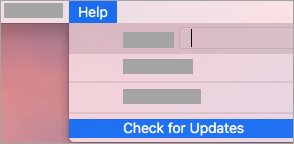Microsoft Word 2007 Mac Window Stuck At Top
Troubleshoot Microsoft AutoUpdate. Open Safari and download the latest version of Microsoft AutoUpdate. Press Command + Shift+h. Go to Library PrivillegedHelperTools and make sure that com.microsoft.autoupdate.helpertool exists. Run Microsoft AutoUpdate. If the file doesn.  Jul 20, 2019 How to Remove Microsoft AutoUpdate from MacOS. From the Finder of MacOS, pull down the “Go” menu and choose “ Go To Folder ” (or hit Command+Shift+G) and enter the following path: Locate the folder named something like “MAU” or “MAU2.0” and open that directory. Locate and drag “Microsoft. Jan 22, 2020 1.Install the latest version of MAU via this link: the latest version of Microsoft AutoUpdate. 2.Restart the Mac. If still enable to install MAU into latest version maybe the local settings had affected the application. 1.First try to reinstall Mac OS updates into latest version. 2.Try creating a new user profile on Mac. Feb 12, 2020 Microsoft AutoUpdate allows you to keep your software up-to-date automatically. AutoUpdate comes with Office, so there's nothing additional to install, and you can also use it to manually check for new downloads as well. Jan 15, 2020 Use the following steps to start using the tool: Open the Terminal application. Enter cd /Library/Application Support/Microsoft/MAU2.0/Microsoft AutoUpdate.app/Contents/MacOS. Run./msupdate -help.
Jul 20, 2019 How to Remove Microsoft AutoUpdate from MacOS. From the Finder of MacOS, pull down the “Go” menu and choose “ Go To Folder ” (or hit Command+Shift+G) and enter the following path: Locate the folder named something like “MAU” or “MAU2.0” and open that directory. Locate and drag “Microsoft. Jan 22, 2020 1.Install the latest version of MAU via this link: the latest version of Microsoft AutoUpdate. 2.Restart the Mac. If still enable to install MAU into latest version maybe the local settings had affected the application. 1.First try to reinstall Mac OS updates into latest version. 2.Try creating a new user profile on Mac. Feb 12, 2020 Microsoft AutoUpdate allows you to keep your software up-to-date automatically. AutoUpdate comes with Office, so there's nothing additional to install, and you can also use it to manually check for new downloads as well. Jan 15, 2020 Use the following steps to start using the tool: Open the Terminal application. Enter cd /Library/Application Support/Microsoft/MAU2.0/Microsoft AutoUpdate.app/Contents/MacOS. Run./msupdate -help.
- Microsoft Word 2007 Mac Window Stuck At Top 5
- Microsoft Word 2007 Mac Window Stuck At Top Picture
- Microsoft Word 2007 Mac Window Stuck At Top 100
Microsoft Word 2007 Mac Window Stuck At Top 5
-->Microsoft Word 2007 Mac Window Stuck At Top Picture
Uninstall Office for your installation type. The steps to uninstall Office depend on the type of installation you have. The most common installation types are Click-to-Run and Microsoft Windows Installer (MSI). The other type is an Office installation from the Microsoft Store app. 2009-12-7 Last week, during the MSDN Roadshow stop in Reston, VA, I helped my fellow presenter Dani Diaz get a wayward Fiddler window back on-screen, after it appeared off-screen when he opened the app during a demo. Folks on hand wanted to know what keyboard shortcut I used, and I just realized that I misspoke at.
Last week, during the MSDN Roadshow stop in Reston, VA, I helped my fellow presenter Dani Diaz get a wayward Fiddler window back on-screen, after it appeared off-screen when he opened the app during a demo.
Folks on hand wanted to know what keyboard shortcut I used, and I just realized that I misspoke at the time as to what the shortcut was…I had said it was alt+shift, when in fact, the keyboard shortcut I used was alt+space. alt+space brings up the window menu for the currently selected window, even if that window is currently off-screen, and the menu will appear on-screen regardless.
So if you run into a situation where you open an application, and the window does not appear on-screen, use alt+tab to switch to that application, then alt+space to open the window menu. Once that menu is open, one of the options should be Move. Select move, and then use the arrow keys to start moving the window…it should immediately pop into view, and once you’ve started the move with the arrow keys you can then move it where you want it with the mouse.
Apologies to the folks who attended the event and who may have been misled by my earlier statement.
One more thing…I mentioned during my talk on Windows 7 for developers that there are a ton of new keyboard shortcuts in Windows 7 that you might be interested in…here’s one list:
Microsoft Word 2007 Mac Window Stuck At Top 100
If you’d like to see more lists you can, of course, Bing it.